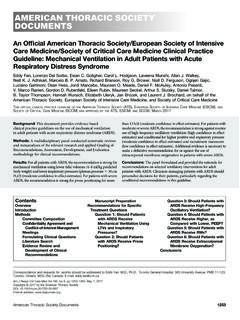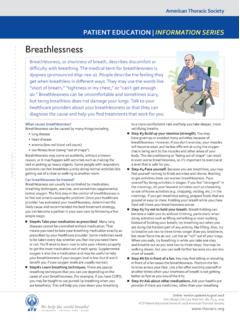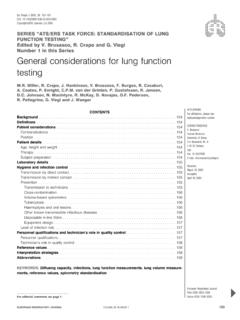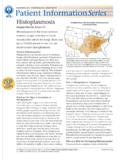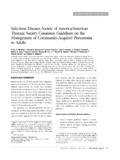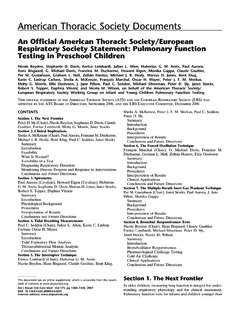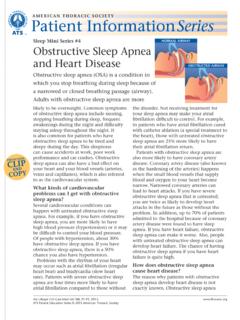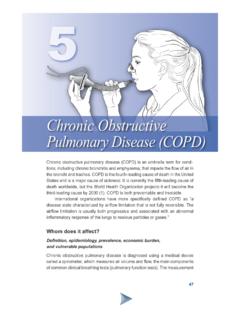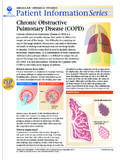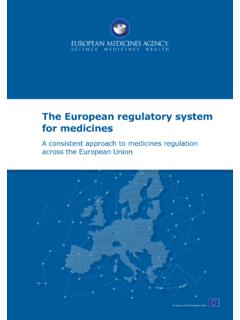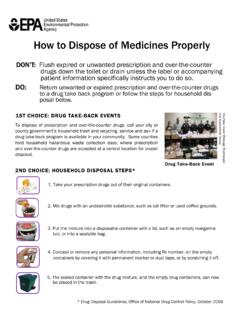Transcription of Medicines for COPD - American Thoracic Society
1 American Thoracic SocietyPATIENT EDUCATION | INFORMATION AND COPYBRONCHODILATORSB ronchodilators are medications that relax the muscles that wrap around your breathing tubes (airways), allowing the tubes to become larger and easier to breathe through. Each bronchodilator is different, based on its: 1) chemical make-up, 2) how fast it works, and 3) how long it lasts. Your healthcare provider will decide with you which of these medications or combinations work best for of bronchodilators: beta2-agonists anticholinergics theophyllinesBeta2-AgonistsInhaled beta2-agonists can be fast-acting (start to work within 3 to 5 minutes) or slow-acting (take 20 minutes to work).
2 Fast-acting beta2-agonists are known as rescue or reliever Medicines because they bring quick relief for breathlessness, but do not last long enough to provide 24-hour relief. Using your reliever medication before an activity that you know makes your breathing worse (such as exercise, showering, or going out into the cold air) may help lessen or prevent your breathing beta2-agonists are short-lasting (last 4 to 6 hours) or long-lasting (last 12 to 24 hours). Examples of short-lasting beta2-agonists are albuterol, levalbuterol, pirbuterol, salbutamol, and terbutaline.
3 Examples of long-lasting beta2-agonists are salmeterol, formoterol, indacaterol, and vilanterol. Long-lasting beta2-agonists are taken every 12 to 24 hours, providing more convenient treatment of COPD than short-acting drugs that are usually used as rescue medications to relieve sudden onset of shortness of and terbutaline are also available in a pill form, but the pill forms can cause more side effects than the inhaled form and take longer to start working so their use has been side effects when taking beta2-agonistsBeta2-agonists are generally safe medications when inhaled but can cause a fast heartbeat.
4 Tremors (shakiness), and rarely cramping of the hands, legs, and feet, particularly if they are used too often or too many puffs are inhaled at once. These medications may also keep you awake at night. The combination of a fast heartbeat and shakiness can cause feelings of anxiety and worsen breathlessness. These side effects often last for only a few minutes after taking the medicine and may totally go away after a few days of regular use. If the side effects do not go away, talk to your healthcare provider. You may need to try a lower dose, change to another type or brand of beta2-agonist, or stop the beta2-agonist.
5 If you have difficulty going to sleep after taking your beta2-agonist, take it an hour or two before bronchodilators are also inhaled Medicines . They have a slower onset of action than beta2-agonists and, therefore, they should never be used for quick relief. Anticholinergics can be short- or long-lasting. The short -lasting form (ipratropium) works in about 15 minutes, lasts for 6 8 hours, and is usually taken up to 4 times a day. The long-lasting forms take about 20 minutes to begin working and lasts for 12 hours (aclidinium) or 24 hours (tiotropium, umeclidinium).
6 Common side effects when taking anticholinergics Anticholinergic bronchodilators do not have as many possible side effects as beta2-agonists. The most common side effects are dry mouth and rarely, difficulty passing urine (urinary retention).Why am I taking two inhaled bronchodilators if they both do the same thing?It may be confusing to understand why you are taking two different bronchodilators. Research studies have shown that combinations of two bronchodilators work better than either alone. A common combination is to give a long-acting beta2-agonist and a long acting anticholinergic.
7 TheophyllineTheophylline is a bronchodilator that is not commonly used for COPD in the since most people can use inhaled bronchodilators. It is usually taken by mouth as a pill. A blood test must be done to monitor your theophylline level to make sure the drug level is high enough to be effective, but not high enough to cause serious side effects. The amount of theophylline that you take needs careful supervision since your theophylline blood level can change when you start a new medicine , stop smoking, or change your diet. A common side effect is shakiness, but very serious side effects include severe nausea, vomiting, heart beat irregularities, and seizures.
8 If you experience any of these, get medical care right away for COPDC hronic obstructive pulmonary disease (COPD) is a chronic disease of the lungs that damages both the airways and the lung tissue, making it difficult to breathe. A person with COPD may have chronic bronchitis (bron-ki-tis), emphysema, or a combination of both conditions. People with COPD often use several kinds of Medicines to help control symptoms. While there is no cure, Medicines can help improve your quality of life. This fact sheet explains different types of Medicines used for COPD.
9 For more information on COPD, see the ATS Patient Information Series at J Respir Crit Care Med Vol. 200, P3-P4, 2019 Online version updated October 2021 ATS Patient Education Series 2019 American Thoracic SocietyAmerican Thoracic SocietyPATIENT EDUCATION | INFORMATION , also known as corticosteroids, are medications used to reduce swelling in the breathing tubes. These drugs are not the same as anabolic steroids (misused by athletes) to build are usually taken by inhaler, often in combination with a bronchodilator. They do not work quickly and may take a week or more before you notice the benefits.
10 If you have an exacerbation or worsening of your COPD symptoms, steroids may be given by mouth in a pill form because pills can act faster (within 24 hours) and provide a higher dose of steroids than the inhaled forms. Using oral steroids for a long period of time (chronically) is discouraged due to significant side side effects when taking steroid medications Side effects depend upon the dose, length of use, and whether taken by pill or inhaled form. The most common side effects of inhaled steroids are a sore throat, hoarse voice, and infections in the throat and mouth.
